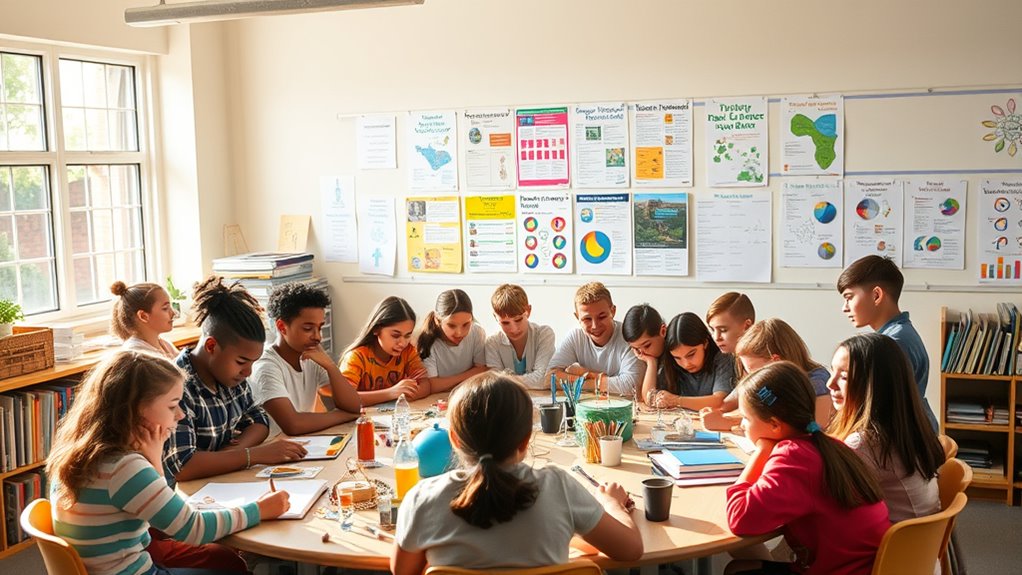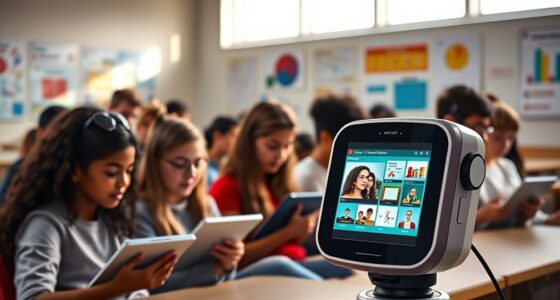Alternative assessments offer a broader view of your learning than standardized tests. They allow you to showcase your understanding in diverse and creative ways, promoting active involvement. You can engage in hands-on activities that enhance critical thinking and practical application. These assessments provide detailed feedback on your strengths and weaknesses, helping tailor instruction to meet your needs. By moving beyond traditional testing, you’ll find a more meaningful approach to education. Discover more about their benefits ahead!
Key Takeaways
- Alternative assessments provide a holistic view of student learning, capturing diverse abilities beyond rote memorization and multiple-choice formats.
- They promote student engagement and ownership of learning through creative, hands-on activities and real-world applications.
- Implementing varied assessment strategies, like portfolios and peer reviews, enriches the educational experience and supports differentiated instruction.
- Detailed feedback from alternative assessments helps identify individual strengths and weaknesses, guiding tailored instructional approaches.
- Moving beyond standardized tests fosters an inclusive environment that values diverse talents, enhancing overall motivation and learning outcomes.

As educators seek more effective ways to measure student understanding, alternative assessments have emerged as a powerful tool. You’re likely familiar with the limitations of standardized tests—they often fail to capture the full spectrum of a student’s abilities and knowledge. Alternative assessments, on the other hand, provide a more holistic view of learning by allowing students to demonstrate their understanding in diverse and creative ways. This shift not only benefits students but also enriches your teaching practice.
Alternative assessments offer a holistic view of student learning, capturing diverse abilities beyond traditional testing methods.
When you implement alternative assessments, you invite students to engage with the material more deeply. Instead of filling in bubbles on a test, they can create projects, participate in presentations, or engage in collaborative problem-solving. This active involvement often leads to a greater sense of ownership over their learning. You’ll notice that students are more motivated and willing to take risks when they can express their understanding in personalized formats that resonate with them.
Alternative assessments also promote critical thinking and practical application. For instance, if you’re teaching a science unit, instead of a traditional exam, you might ask students to design an experiment or build a model. This approach encourages them to apply concepts in real-world situations, enhancing their comprehension and retention. You’re not just evaluating what they know; you’re gauging how they think and problem-solve, which is essential for their future success. Implementing best practices in software quality assurance can also enhance how students approach their assessments, ensuring they develop a methodical and analytical mindset.
Moreover, these assessments provide you with valuable insights into your students’ strengths and areas for improvement. The feedback you gain from projects and presentations is often more detailed and nuanced than what you’d get from a standardized test score. You can tailor your instruction based on this information, ensuring that each student receives the support they need to thrive. This adaptability helps you foster a more inclusive classroom environment where every learner feels valued.
Incorporating alternative assessments doesn’t have to be overwhelming. Start small by integrating one or two new methods into your existing curriculum. You might begin with peer reviews or self-assessments, gradually expanding to larger projects or portfolios. By doing this, you’re not only diversifying your assessment strategies but also enriching your students’ learning experiences.
Ultimately, as you embrace alternative assessments, you’re moving beyond the confines of standardized testing. You’re creating a dynamic learning environment that recognizes and celebrates the diverse talents of your students, making education a more meaningful journey for everyone involved.
Frequently Asked Questions
What Are Some Examples of Alternative Assessments?
Some examples of alternative assessments include portfolios, where you collect and showcase your work over time, and performance tasks, which require you to demonstrate skills in real-world scenarios. You might also engage in peer assessments, giving and receiving feedback from classmates, or use self-assessments to reflect on your learning. Project-based learning is another great option, allowing you to explore topics deeply and present your findings creatively. Each method offers unique insights into your abilities.
How Do Alternative Assessments Benefit Diverse Learners?
Alternative assessments benefit diverse learners by allowing you to showcase your strengths in various ways. They cater to different learning styles, offering options like projects, portfolios, or presentations. This flexibility helps you engage more deeply with the material. You’re able to demonstrate your understanding without the pressure of traditional testing formats. Plus, these assessments often encourage collaboration, fostering a sense of community and support among peers, which can enhance your overall learning experience.
Can Alternative Assessments Be Used in Standardized Testing Environments?
Yes, you can use alternative assessments in standardized testing environments. By integrating varied formats like portfolios, projects, or presentations, you capture a broader range of student abilities. This approach not only enriches the assessment experience but also allows you to accommodate diverse learning styles. While traditional tests measure specific knowledge, alternative assessments can provide deeper insights into a student’s understanding, promoting a more inclusive and all-encompassing evaluation process.
What Skills Do Alternative Assessments Aim to Measure?
Alternative assessments aim to measure a variety of skills, including critical thinking, problem-solving, creativity, and collaboration. They focus on how well you can apply knowledge in real-world contexts, rather than just recalling facts. You’ll often find these assessments evaluating your ability to analyze information, work in teams, and communicate effectively. By emphasizing practical skills, alternative assessments provide a more all-encompassing view of your abilities and readiness for future challenges.
How Are Teachers Trained to Implement Alternative Assessments Effectively?
Did you know that over 70% of teachers feel unprepared to implement alternative assessments? To effectively use these methods, you’ll undergo specialized training that focuses on hands-on strategies, collaboration techniques, and assessment design. You’ll learn to create rubrics, use portfolios, and engage students in self-assessment. Ongoing professional development helps you stay updated on best practices, ensuring you can foster a supportive learning environment that encourages creativity and critical thinking in your classroom.
Conclusion
In the vibrant landscape of education, alternative assessments bloom like wildflowers, offering a invigorating escape from the rigid pathways of standardized tests. These assessments invite you to explore the rich tapestry of student potential, where creativity and critical thinking intertwine. By embracing diverse evaluation methods, you’re not just measuring knowledge; you’re crafting a symphony of learning that resonates with every unique learner. So, let’s cultivate this garden of understanding and nurture the diverse talents that lie within each student.









